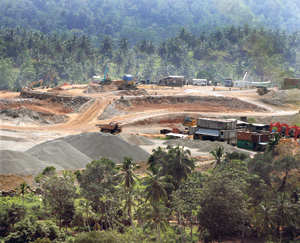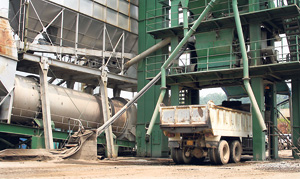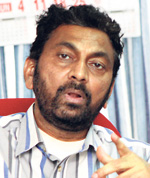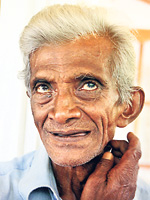ON THE SOUTHERN EXPRESSWAY - It was like driving through a different country in Asia – the landscape, the green paddies, stretches of green vegetation as far as can meet the eye, very few people around and a nicely paved road where travelling at a speed of 120 km per hour was as smooth as cruising at 40 km per hour on a regular highway.

Construction site. Pix by J Weerasekera |
“This is like the expressway from Penang to Kuala Lumpur (in Malaysia),” exclaimed one journalist, after a spectacular drive on the 4-lane highway near Galle. The southern expressway, once completed, would be one of the most ambitious development projects undertaken in the country.
On Monday, a team of business journalists were taken on a conducted tour by the Colombo office of the Asian Development Bank (ADB), probably the first time the media has been formally allowed on a part of the expressway since the project began in the later 1990s. Joining the group was Admiral (Retd) Wasantha Karannagoda, Secretary to the Ministry of Highways and senior officials of the Road Development Authority (RDA), the implementing agency.
Like any mega infrastructure project in the world, the Southern Transport Development Project (STDP) has had its share of problems, crises, worries and accidents but the main issue was opposition from residents in the acquisition of their land, re-settlement while cost overruns due to these delays saw the project cost rise sharply.
At a briefing to the visiting journalists at the RDA site office at Balapitiya, Project Director S.S. Meihandan said there have been six fatalities since construction began in 2002, among which was a man getting electrocuted and a school boy being crushed when a metal underpass collapsed due to bad construction.
While a 100 % accident-free project would be the ideal situation and any accident must be avoided, both Mr Karannagoda and ADB Sri Lankan Country Director Richard Vokes explained that in all big infrastructure projects in the world, accidents have happened though generally efforts are made to ensure trouble-free construction or minimise the incidents.

Asphalt plant |
The most serious incident recently was the collapse of a metal underpass at Kurunudugahetekma near Balapitiya pinning down a school boy while he was returning from school. His colleague accompanying him escaped. “The problem was due to bad construction and the sub contractor has been fired,” noted Prof. Tishan Jayasinghe, Prof of Civil Engineering, University of Moratuwa, head of a Presidential Committee appointed to probe the accident, while showing the group the area where the accident occured.
He said the Moratuwa University is now looking at ways of strengthening these metal, arch-like structures below the highway which are to be used as a road access or water outlet. “These structures follow standards that are used in road projects across the world. However we want to find ways of reinforcing the metal structures to restore some confidence in the people,” he said.
The journalists were driven on stretches of the ADB-funded part of the 30 km asphalt-laid highway between Balapitiya and Galle, much of which has been completed except for a few bridges and the final touches – road signs, toll gates, road markings, a centre median and protective barriers on the roadsides. There are no traffic lights, stop signs or (brace yourself for this) POLICE. Speeding is allowed as long as your vehicle is in a good condition and you don’t drive to kill. A trip from Kottawa near Maharagama (where the expressway starts) to Galle will take less than half the time spent when taking the 115-km, non-stop drive on the normal, busy Galle Road.

Admiral (Retd) Wasantha Karannagoda |
“There will be a toll (charge) for the use of the road but it would be reasonably priced and cost-effective to the user as you save on fuel, time and getting caught up in traffic,” said Mr Karannagoda. Road maintenance and operation of the toll gates will come under an Expressway Authority which will also be responsible for other expressways including the Colombo-Katunayake expressway where construction is due to begin next year.
All along the stretches that the journalists were taken, most noticeable (on this 30 km stretch of the expressway) was that the road ran through several mountains and hills amidst stretches of rice fields, tea bush and forests. Mountains have been neatly blasted while the hillsides are nicely sloped and shaved to reflect a sense of beauty and blend with the environment.
Cladding (netting) sprayed with fertilizer, has been rolled on the mountainsides with grass growing on it to firm the slopes and prevent erosion. Way up on the hills, large drains have been constructed to guide the water through outlets and avoid water flowing down the slopes. At one slope, workers were meticulously cementing some crevices which engineers said could allow water to seep in and lead to erosion. Construction all along the 120 km expressway is due for completion by mid 2011.

Jinadasa Hatharasinghe |
So far nearly 90 % of the ADB section has been completed, while the JICA (Japanese International Cooperation Agency)-funded 90 km stretch from Kottawa to Balapitiya is 50-60% complete while construction of the last 30 km stretch from Galle to Matara is due to begin in December with an Exim Bank of China loan. The total cost of the entire project is Rs 85 billion inclusive of payment of compensation to 1,370 households and acquisition of land for resettlement. The expressway will only be accessible to cars, buses and other heavy vehicles. No bicycles, motorbikes, tractors or three wheelers will be permitted.
Entry to the expressway will be through 11 ‘interchanges’ or access points (from other main roads) which will have a toll gate. The expressway is fenced right across the 120 km stretch. The expressway was first intended to be a 4-lane highway for the first 30 km followed by a 2-lane highway for the rest of the way to Matara. Subsequently that was changed to a 4-lane highway to Matara with provision to expand it to six lanes later depending on the need. RDA and ADB officials said these changes led to the delay in construction.
The group of journalists was also shown one of the resettlements where Jinadasa Hatharasinghe, 75 years and a former CEB employee, said he had received compensation of Rs 1.6 million and moved into the new settlement. Speaking to reporters in the presence of Mr Karannagoda, ADB and RDA officials, he said though he was disturbed at first to be relocated, he was happy in his new home.
Project Director Meihandan said costs have risen sharply over the years due to the fuel prices and there has been a huge cost overrun due to this.
ADB’s Vokes said the bank presented the first loan for $90 million in November 1999 and when changes were made in the project, a supplementary loan of $90 million was approved in 2008. He said the project was delayed for three years due to resettlement, geological issues and court cases by residents. Mr Karannagoda said they hope to complete all major road projects by mid 2011.
Work on the other big development, the Outer Circular Road in Colombo, will also began as soon as funding for the third and final phase is finalized. |




